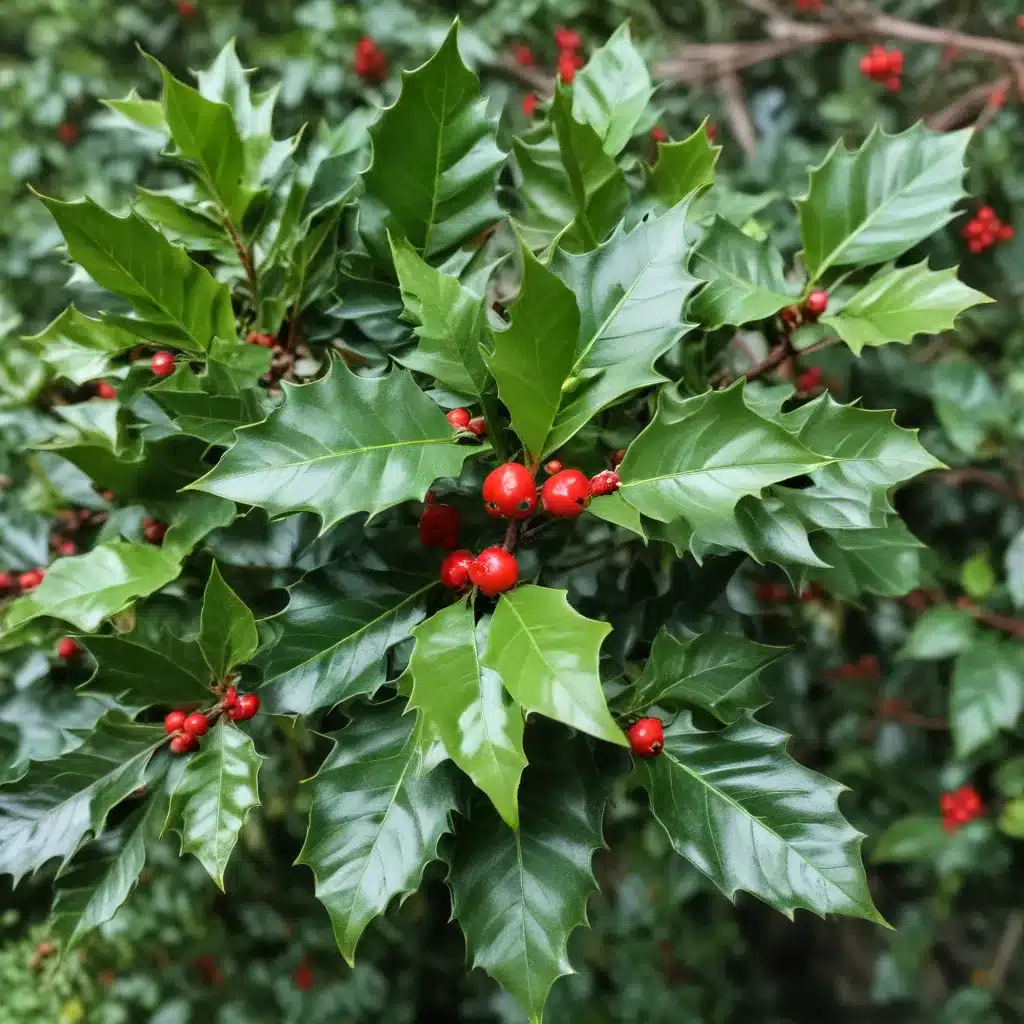
Botanical Characteristics of Holly
The holly (Ilex spp.) is a captivating genus of evergreen shrubs and trees renowned for its distinctive foliage and vibrant berries. With over 600 species found worldwide, the holly’s diverse array of shapes, sizes, and growth habits makes it a versatile addition to any landscape.
At the heart of the holly’s allure are its evergreen leaves. Leathery, glossy, and often sporting a spiny, serrated edge, the holly’s foliage provides year-round visual interest. The leaves’ waxy texture and deep green hue create a striking contrast against the plant’s bright red berries. This signature combination of colors and textures has cemented the holly’s status as a beloved holiday decoration and enduring symbol of the winter season.
The holly’s berry clusters are another hallmark of the genus. These spherical, scarlet-colored fruits typically appear in late fall and persist well into the winter months, providing a vital food source for local wildlife. While the berries are mildly toxic to humans, they are an essential component of the holly’s natural appeal and ecological function.
Seasonal Significance of Holly
The holly’s evergreen nature and vibrant winter display have long imbued the plant with deep cultural and symbolic significance, particularly during the holiday season. Across many traditions, the holly’s resilience and ability to thrive even in the harshest winter conditions have made it a representation of life, hope, and the persistence of nature.
In ancient pagan rituals, the holly was revered for its ability to ward off evil spirits and bring good fortune. As Christianity spread, the plant’s associations evolved, with the holly’s spiny leaves coming to symbolize the crown of thorns worn by Jesus, and its red berries representing the blood he shed. This intertwining of pagan and Christian symbolism has cemented the holly’s place as a cherished holiday decoration, gracing homes, churches, and public spaces with its timeless elegance.
Beyond the winter holidays, the holly’s year-round ornamental appeal makes it a popular choice for landscaping and floral arrangements. Its glossy foliage and striking berry clusters provide visual interest throughout the changing seasons, adding a touch of natural beauty to any setting. Whether incorporated into winter wreaths and garlands or utilized as a standalone specimen plant, the holly’s versatility ensures its enduring popularity.
Horticultural Considerations
When it comes to cultivating the Ilex genus, gardeners and horticulturists must consider a variety of factors to ensure the plant’s optimal growth and health. Proper site selection, planting techniques, and ongoing maintenance are crucial for successfully incorporating holly into the landscape.
Holly plants thrive in well-drained, acidic soil and prefer partial to full sun exposure, depending on the specific cultivar. While some species, such as the American holly (Ilex opaca), can grow to impressive heights of 50 feet or more, many modern holly cultivars have been bred for a more compact, manageable size, making them well-suited for residential and urban settings.
Pruning and shaping are essential for maintaining the holly’s signature shape and encouraging dense foliage growth. Regular trimming, particularly in the late winter or early spring, can help control the plant’s size, promote branching, and enhance its overall aesthetic appeal. Gardeners must exercise caution, however, as the holly’s spiny leaves can pose a risk if not handled properly.
With an ever-expanding array of holly cultivars available, homeowners and landscape designers can select from a wide range of sizes, shapes, and leaf forms to suit their specific needs and preferences. From the classic American holly to the more compact blue holly (Ilex x meserveae) and the vibrant winterberry (Ilex verticillata), the genus offers endless possibilities for adding year-round interest and beauty to any landscape.
Ecological Role of Holly
Beyond its ornamental value, the holly plays a vital role in the natural ecosystem, providing important habitat and sustenance for a variety of wildlife species. The plant’s evergreen foliage and persistent berries offer shelter, nesting sites, and a reliable food source for birds, small mammals, and other fauna.
The American holly (Ilex opaca), in particular, is a crucial component of many Eastern North American forest ecosystems. Its dense, spiny leaves offer protection for numerous bird species, including the threatened American Woodcock and the declining Wood Thrush. The holly’s berries also provide a valuable food source for these and other migratory birds, especially during the lean winter months.
Beyond its importance for avian species, the holly also plays a role in supporting broader biodiversity. Its tolerance for drought and resistance to many common pests and diseases make it a hardy, resilient addition to the landscape. By incorporating holly into gardens and natural areas, homeowners and land managers can help foster a more diverse and thriving ecosystem.
As we continue to navigate the challenges of urbanization and habitat loss, the holly’s ecological significance underscores the importance of incorporating native plants into our landscapes. By embracing the holly and other native species, we can not only enhance the visual appeal of our outdoor spaces but also contribute to the overall health and sustainability of our local ecosystems.
Whether used as a decorative accent, a reliable wildlife habitat, or a symbol of enduring tradition, the holly’s unique characteristics and multifaceted role make it an indispensable component of the natural world. As you plan your next landscaping project or holiday décor, consider the elegant evergreen holly and the many ways it can enrich your outdoor environment. For high-quality, sustainably sourced holly products and arrangements, visit TriCounty Tree Care – your trusted source for all things related to this captivating plant.


